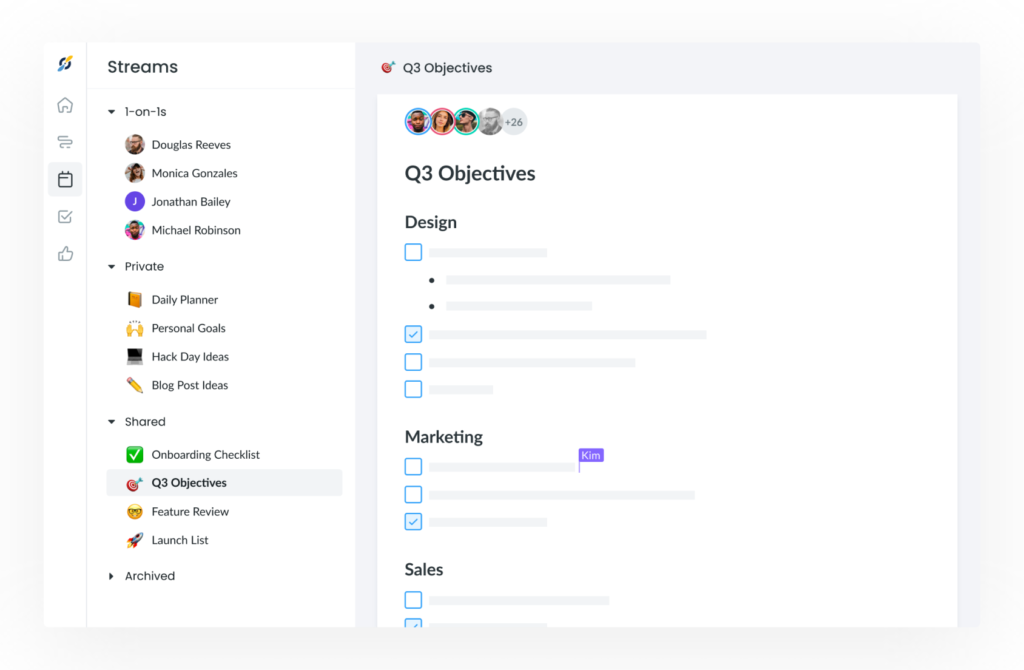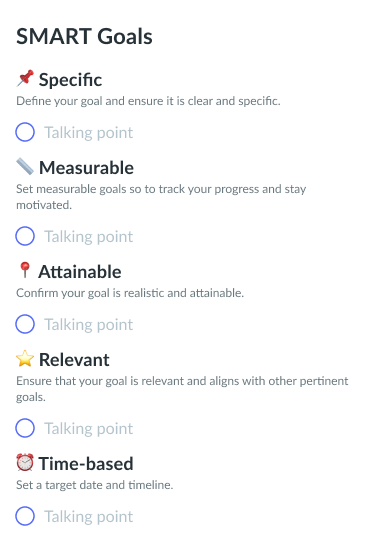How to Achieve Professional Development Goals [+ Examples & Templates]
Creating and setting professional development goals will help you grow and find alignment in your career. Learn how to achieve them here.
Setting professional development goals is one of the best ways for you to grow, find alignment, and increase productivity at work. While you can set these goals solo, it’s a great idea to share and revise your professional goals in a one-on-one meeting with your manager. This way, you can track your progress as you expand your skills and competencies over time. Whether your focus is on soft or hard skills, you can discover how to achieve your professional development goals by setting and modifying them as you continue to work on them. This article covers what professional development goals are, some examples of them, and seven solid tips and tricks to achieve your own.
- What are professional development goals?
- Why should you set professional development goals?
- Examples of professional development goals
- 7 ways to achieve your professional development goals
- Free goal-setting meeting agenda templates
What are professional development goals?
Professional development goals concern any types of goals that are set around learning, engaging, or maintaining professional knowledge or competencies. Professional development can pertain to any training, education, certifications, or learning that supports employees in improving their effectiveness at work. Typically, professional development goals are formally recorded so you and your manager can review and track them over time. Professional development enhances the skills you already have and identifies areas that can be nurtured and grown further so you can feel more confident and even more effective in your job. Goal management is therefore a central part of your professional development.

Stay on track of professional development goals
Organize and track your goals in a personal or shared stream to stay on top and achieve your professional development goals. Try a tool like Fellow today!

Why should you set professional development goals?
You should consider setting professional development goals with your manager for several reasons. First, doing so is a great way of firstly identifying where you are in your career and where you would like to go. After you’ve identified what you would like to achieve in your career, you can then start identifying the necessary steps that will get you to your end goal. Setting professional goals can help you develop a new skill set, take up leadership responsibilities, and find better job opportunities down the line. When you set professional development goals, you can also develop interpersonal skills and take the time to discover new interests and skills. When you work on your career, you also create new opportunities to expand your professional network and find different ways to deepen your job satisfaction.
Examples of professional development goals
- Example 1- Deepen job satisfaction
- Example 2- Learn a new skill or competency
- Example 3- Gain experience in a different department
Example 1- Deepen job satisfaction
Goal: Deepen job satisfaction.
Purpose: Achieve higher productivity and less turnover.
Tangible steps to be taken to reach this goal:
- Clarify boundaries on work expectations outside of working hours
- Create a plan to prepare enjoyable and healthy meals for lunch
- Set reminders to take intermittent breaks throughout the day
- Schedule lunch or coffee chats with coworkers
- Join or start a workplace interest group
- Start a work journal to track how you’re feeling at work
Timeline: By the end of the quarter, you hope to feel more satisfied with the work that you’re doing.
Example 2- Learn a new skill or competency
Goal: Learn a new skill or competency.
Purpose: Begin to build new skills so that advancement opportunities become more readily available.
Tangible steps to be taken to reach this goal:
- Self teach through industry books, blogs, and videos
- Take a relevant course
- Earn a certification in your field in the next quarter
- Look for mentoring opportunities
- Shadow another department
Timeline: By the end of the year, you want to acquire two new skills that will support you in your principal responsibilities.
Example 3- Gain experience in a different department
Goal: Gain experience in a department to which you have not yet been exposed.
Purpose: Acquire exposure to different departments to gain experience that will help project management skills.
Tangible steps to be taken to reach this goal:
- Request to attend meetings in other departments
- Ask to take meeting minutes in other department meetings
- Shadow another department
- Look for mentoring opportunities
- Have coffee chats with coworkers to ask for advice and opinions on their work and responsibilities
Timeline: By the end of the year or quarter, you hope to secure a job shadowing opportunity and complete one training program relevant to another department.
7 ways to achieve your professional development goals
- Be realistic
- Track your progress
- Set SMART goals
- Prioritize your goals
- Gather the resources you need
- Create milestones
- Surround yourself with people who have similar goals
1 Be realistic
The first thing you need to keep in mind when setting professional development goals is that these goals need to be realistic and achievable. When you set goals that are realistic and reasonable, you’ll be much more likely to attain them. That feeling of accomplishment will be good for your professional development because it will further motivate you to continue achieving subsequent goals. With realistic goals, you can hold yourself accountable and ensure that you’re taking the necessary steps towards your achievements.
2 Track your progress
It’s essential that you track your progress so you can stay on top of your goals and ensure that you’re on track to hit them. For instance, a huge benefit of objectives and key results (OKRs) is that they track your customer success team’s progress. With Fellow’s Objectives tool, you can define and track your OKRs with the added benefit of reviewing these objectives during your one-on-one meetings with your manager so you can ensure that you’re exactly where you need to be. Because the key results from your OKRs are quantifiable, measurable, and time-bound, you can easily gauge your professional development progress in Fellow.

3 Set SMART goals
SMART goals are notorious for a reason—because they’re so effective. They are goals that are specific, measureable, achievable, relevant, and time-bound. Your professional development goals should be well defined and unambiguous so you know exactly what you’re aspiring to do. You should also be able to clearly identify if you have achieved your goals. According to the SMART goal framework, setting a goal that you can realistically achieve is key to actually achieving the goal. Lastly, your professional development goals need to be relevant to you. This means that they should align with your long-term career aspirations and values. The time-bound component means that you should set a deadline for your goals so you can stay on track.
4 Prioritize your goals
It’s a good idea to take some time to consider which goals are most important to you. When you prioritize the professional development goals you’re working towards, you’ll find it easier to break down large goals into more manageable tangible tasks to complete. You’ll need to prioritize your goals on a constant basis so you can continuously consider your progress and rethink the order in which you would like to achieve your goals. This prioritization will also help you track where you currently are and what still requires your further attention.
5 Gather the resources you need
When you set your professional development goals, consider the resources that are required to make your goals achievable. Strategize which kinds of tools, resources, time, and training may be needed to reach your professional development goals. Be ready to propose a means to acquire or use these resources to your boss and be able to explain how using these resources is mutually beneficial for your own development but also for the benefit of the company. Where there may be a time commitment required from you, consider how you will make time for your goals while still effectively completing your day-to-day tasks.
6 Create milestones
Create milestones for yourself so there are smaller wins to celebrate on your way to achieving your larger professional development goals. After you plan for these milestones and actually complete the work that is required to achieve them, these wins will motivate you to keep working hard so you can meet the next milestone on your professional development journey. Don’t forget to celebrate these milestones and the progress that you’re making. Working on your career is an amazing accomplishment that should be acknowledged!
7 Surround yourself with people who have similar goals
The people with whom you spend the most time have a huge influence on you and on your habits. Be sure to spend time with people who are also prioritizing their growth and focusing on further development in their careers. When you spend time with individuals who are motivated, ambitious, goal-oriented, and supportive of you, it’s much more likely that you will hit your own professional development goals. There’s a reason people say you are who you surround yourself with! So be sure to have an entourage that shares similar values and never ceases to cheer you on.
Free goal-setting meeting agenda templates



Parting advice
The ability to learn and grow in any career is essential for your happiness and effectiveness at work. If you’re looking to boost your effectiveness and productivity in the office, consider setting professional development goals with your boss. With their support, you can track your goals over time and ensure that you’re hitting your milestones according to the timeline you’ve set. Remember to set realistic goals so you can continuously attain them and advance your professional development journey. Professional development goals will motivate you and hold you accountable in building your dream job, so don’t forget to try out one of our goal-setting meeting agenda templates so you can put your aspirations into action.











